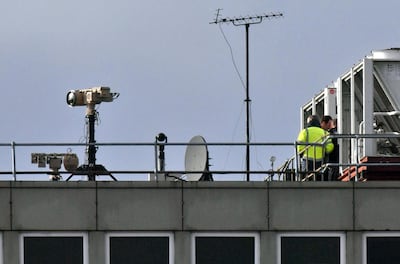It was an incident that brought one of Europe's biggest airports to a standstill, with scores of flights suspended, thousands of travellers stranded in the busy Christmas period and the military even called in to help solve the growing crisis.
Yet the havoc wreaked on Gatwick Airport in England in recent days was not caused by a terror threat or even extreme weather conditions, but was the result of diminutive drones flying near the area in a "deliberate act".
A seemingly well-orchestrated stunt that led to the closure of an airport has raised questions about just how easy it is to stop a drone, particularly when remotely controlled by someone with ill-intent.
British police have arrested two people in connection with the drone usage which caused hundreds of flights to be cancelled to and from London’s Gatwick Airport.
Multiple approaches can be used to disable drones that are causing a hazard, but many technologies have yet to be widely deployed against craft that are evolving at what an official report describes as a “lightning pace”.
Measures to combat rogue drones range from preventing the operator from controlling the craft to catching it in nets and carrying it to safety.
A 2018 report, Counter-Unmanned Aircraft System Capability for Battalion-and-Below Operations, released by the US National Academies of Sciences, Engineering and Medicine, says the capabilities of "small unmanned aircraft systems" (sUASs) are accelerating rapidly.
“Detection and identification are very difficult because these sUASs are small, can fly at low altitude, and can have highly irregular flight paths that can range in speed from zero (hover) to close to 18 metres per second,” the report states.
Complicating this is “background clutter” such as birds and trees that drones can take advantage of to evade efforts to disable them.
Once detected and identified, neutralizing a small drone is “a separate and even greater challenge”, with the report saying that using a rifle, shotgun or light machine-gun to shoot down a small drone is “extremely difficult due to the agility and size of sUASs”.
There are also safety concerns about shooting such objects out of the sky.
Gatwick chief operating officer Chris Woodroofe said police decided against shooting down the drones at the airport with firearms because of "what might happen with stray bullets."
Despite the difficulties, equipment to capture drones using netting fired from a shoulder-mounted or ground gun is available commercially.
Such a shoulder-mounted device, the SkyWall 100, made by a British company, was deployed as a security measure in 2016 when the then US president, Barack Obama, visited Berlin.
Such surface-to-air technologies can, however, struggle to disable a target drone if it is high in the sky.
Alternatives include using drones that crash into rogue drones, or drones that can drop a net onto a drone and carry it off, which not only neutralizes the rogue drone, but preserves the evidence.
______________
Read more:
Two arrested after Gatwick drone disruption
Gatwick chaos: What went wrong?
Gatwick chaos: Airport reopens as military measures ensure flight safety
______________
The use of lasers against drones has also been demonstrated, with the aircraft manufacturer Boeing having developed a system involving infra-red cameras that can reportedly locate and incapacitate small drones at a distance of several miles.
In a less high-tech approach, eagles have been trained to capture small drones. While this makes use of these birds' exceptional hunting capabilities, it involves expensive training and could expose the birds to the risk of injury from the rotors of larger drones.
Given the increasing use of drones in warfare – the Islamic State group has employed them in Syria, for example, and Russia has used them in Ukraine to locate Ukrainian units – much research into deploying and combating drones has been carried out by the world's militaries.
There is particular concern that warfare could, the National Academies of Sciences' report notes, see the use of “swarms” of drones, creating the challenge of quickly disabling multiple craft.
The report also states that it can be much more expensive to develop a system to combat a drone than it is to create that drone in the first place, meaning that the odds are stacked against defensive measures.
Apart from physical means to combat drones, there are also electronic disruption methods.
Often a lack of robust encryption in the signalling between operator and drone means that the devices can be easy to hack and take control of.
Specialists have hacked drones from more than a mile away, replacing the drone operator's instructions with their own.
Commercially available “jamming” equipment sends radio waves of the same frequency as those used by the drone operator, preventing the operator from controlling the craft, which often then crashes.
In recent days one vendor claimed that his technology could secure major airports such as Gatwick and Heathrow, although the British government has said there is no single solution that can deal with the threat.
In another approach, the software of drones can be made to block the craft from entering “no-go zones”, such as airports and their vicinity, although this can be disabled by hackers.
Efforts to combat drones based on disrupting the signals being sent to them are ineffective against craft that are flying autonomously and are not being controlled by an operator nor making reference to the GPS satellite navigation system.
So while the ways of combating drones are many and various, none yet appears to be the definitive answer to dealing with the hazards they pose.



